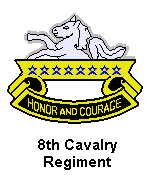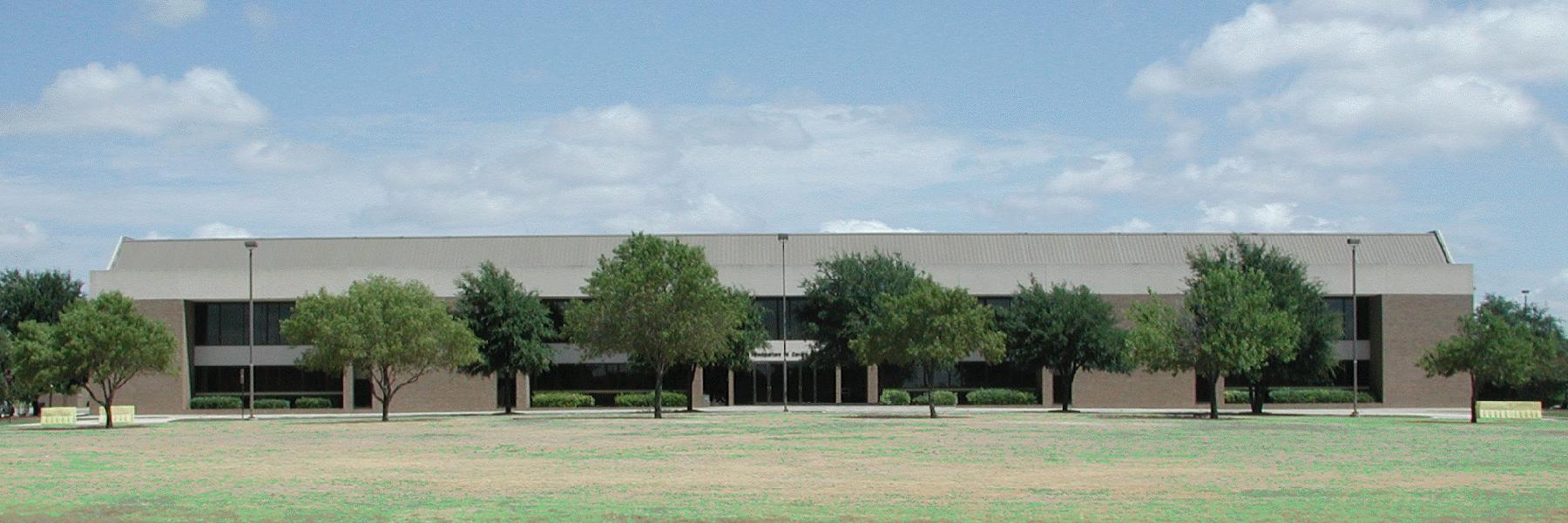

8th Cavalry Regiment
In Readiness
"Honor and Courage"

![]()



![]()
|
|---|
![]() TRICAP, an acronym for TRIple-CAPability, was derived from combining the
ground (mechanized infantry or armor) capability, airmobile infantry and air
cavalry or attack helicopter forces. TRICAP I was held at Fort Hood, Texas
beginning in February 1972. The purpose of TRICAP I was to investigate the
effectiveness and operational employment of the TRICAP concept at battalion
and company levels when conducting tactical operations in a 1979 European
mid-intensity warfare environment. The exercise consisted of six phases;
movement to contact, defense and delay, exploitation, elimination of
penetration, rear area security and night elimination of penetration in an
adjacent area.
TRICAP, an acronym for TRIple-CAPability, was derived from combining the
ground (mechanized infantry or armor) capability, airmobile infantry and air
cavalry or attack helicopter forces. TRICAP I was held at Fort Hood, Texas
beginning in February 1972. The purpose of TRICAP I was to investigate the
effectiveness and operational employment of the TRICAP concept at battalion
and company levels when conducting tactical operations in a 1979 European
mid-intensity warfare environment. The exercise consisted of six phases;
movement to contact, defense and delay, exploitation, elimination of
penetration, rear area security and night elimination of penetration in an
adjacent area.
![]() On 26 June 1972, the 2nd Battalion, 8th Cavalry along with the 3rd Brigade
(Separate) was brought back to the United States, completing the last stage of
the "Vietnam recall" for the 1st Cavalry Division which had started over a
year earlier on 05 May 1971. On 28 June, the 2nd Battalion was inactivated at
Fort Hood, Texas. Their period of inactivation was short lived. On 20 April
1974, the 2nd Battalion, 8th Cavalry Regiment was reactivated, redesignated
2nd Battalion, (Armor), 8th Cavalry and reassigned to the 1st Cavalry
Division, Fort Hood, Texas where it has been to the present.
On 26 June 1972, the 2nd Battalion, 8th Cavalry along with the 3rd Brigade
(Separate) was brought back to the United States, completing the last stage of
the "Vietnam recall" for the 1st Cavalry Division which had started over a
year earlier on 05 May 1971. On 28 June, the 2nd Battalion was inactivated at
Fort Hood, Texas. Their period of inactivation was short lived. On 20 April
1974, the 2nd Battalion, 8th Cavalry Regiment was reactivated, redesignated
2nd Battalion, (Armor), 8th Cavalry and reassigned to the 1st Cavalry
Division, Fort Hood, Texas where it has been to the present.
![]() On 21 February 1975, the end of TRICAP evaluations, the mission of airmobile
anti-armor warfare was transferred to the 6th Cavalry Brigade (Air Combat)
co-located at Fort Hood, Texas and the 1st Cavalry Division was reorganized
and redesignated to become the newest Armored Division in the Army,
essentially the battle configuration it retains today. It would not be until
the end of the Gulf War and subsequent reorganization of 29 November 1992,
when the 1st Battalion, 67th Regiment, 2nd Armored Division would be reflagged
as the 3rd Battalion, 8th Cavalry Regiment and assigned to the 1st Cavalry
Division, filling out the present organization structure.
On 21 February 1975, the end of TRICAP evaluations, the mission of airmobile
anti-armor warfare was transferred to the 6th Cavalry Brigade (Air Combat)
co-located at Fort Hood, Texas and the 1st Cavalry Division was reorganized
and redesignated to become the newest Armored Division in the Army,
essentially the battle configuration it retains today. It would not be until
the end of the Gulf War and subsequent reorganization of 29 November 1992,
when the 1st Battalion, 67th Regiment, 2nd Armored Division would be reflagged
as the 3rd Battalion, 8th Cavalry Regiment and assigned to the 1st Cavalry
Division, filling out the present organization structure.
![]() In 1980, as part of the continuous Force Modernization and Preparation for
combat of the unknown enemies of the future, the division was chosen to field
test the new XM-1 tank. At the same time the division shed the battle weary
M551 Sheridan armored reconnaissance airborne assault vehicles for M60 tanks.
Meanwhile, the 1st Battalion, 7th Cavalry Regiment and supporting troops of
the 8th Cavalry Regiment were deployed to Germany as part of the Emergency
Deployment Readiness Exercise to put together a combat ready tank battalion
using stored (prepositioned) equipment. This mission lead to the formation of
the annual autumn exercises to become known as REturn of FORces to GERmany
(REFORGER).
In 1980, as part of the continuous Force Modernization and Preparation for
combat of the unknown enemies of the future, the division was chosen to field
test the new XM-1 tank. At the same time the division shed the battle weary
M551 Sheridan armored reconnaissance airborne assault vehicles for M60 tanks.
Meanwhile, the 1st Battalion, 7th Cavalry Regiment and supporting troops of
the 8th Cavalry Regiment were deployed to Germany as part of the Emergency
Deployment Readiness Exercise to put together a combat ready tank battalion
using stored (prepositioned) equipment. This mission lead to the formation of
the annual autumn exercises to become known as REturn of FORces to GERmany
(REFORGER).
![]() In September 1982, the division's first National Training Center (NTC)
rotation at Fort Irwin, located in the High Mojave Desert of California,
kicked off a long on-going series of tough, realistic desert battles which
enables the division to stay on the leading edge of warfare technology of
today. The first units to attend were the 2nd Battalion, 7th Cavalry and 3rd
Battalion, 10th Cavalry of the 2nd Brigade. The Division now conducts three
NTC rotations per year.
In September 1982, the division's first National Training Center (NTC)
rotation at Fort Irwin, located in the High Mojave Desert of California,
kicked off a long on-going series of tough, realistic desert battles which
enables the division to stay on the leading edge of warfare technology of
today. The first units to attend were the 2nd Battalion, 7th Cavalry and 3rd
Battalion, 10th Cavalry of the 2nd Brigade. The Division now conducts three
NTC rotations per year.
 |
|---|
| 1st Cavalry Division Headquarters - 1980 |
![]() In the fall of 1983, the division deployed to Europe for the annual REFORGER
exercises. This deployment was consistent with the contingency plans for its
NATO reinforcement role. REFORGER '83 was the largest deployment of the
division since Vietnam. A real test of war equipment repositioned stocks,
REFORGER also marked the first time the exercise was lead by the Dutch.
In the fall of 1983, the division deployed to Europe for the annual REFORGER
exercises. This deployment was consistent with the contingency plans for its
NATO reinforcement role. REFORGER '83 was the largest deployment of the
division since Vietnam. A real test of war equipment repositioned stocks,
REFORGER also marked the first time the exercise was lead by the Dutch.
|
|---|
![]() At Fort Hood, the division through deliberate planning, evolved into the
combat unit which would be eventually assigned a major role in the Gulf War.
Along with the constant training of personnel, equipment was updated. The
XM-1 tank, renamed the M1 Abrams, was accepted and issued, along with
the BFV (Bradley M2 Infantry) and CFV (M3 Cavalry) fighting vehicles. New
technology was fielded in the MLRS (Multiple Launched Rocket Systems) and the
AH-64 Apache helicopter with its "Hellfire" guided missile. The old reliable
Jeep bowed to the HEMTT (Heavy Expanded Multi-purpose Tactical Truck), capable
of hauling fuel, ammunition and various cargos, and the HMMWV (High Mobility
Multi-purpose Wheeled Vehicle, configured as troop/cargo carrier, light
armored personnel carrier, communications equipment carrier and ambulance, -
both of which proved to be invaluable in the Gulf War.
At Fort Hood, the division through deliberate planning, evolved into the
combat unit which would be eventually assigned a major role in the Gulf War.
Along with the constant training of personnel, equipment was updated. The
XM-1 tank, renamed the M1 Abrams, was accepted and issued, along with
the BFV (Bradley M2 Infantry) and CFV (M3 Cavalry) fighting vehicles. New
technology was fielded in the MLRS (Multiple Launched Rocket Systems) and the
AH-64 Apache helicopter with its "Hellfire" guided missile. The old reliable
Jeep bowed to the HEMTT (Heavy Expanded Multi-purpose Tactical Truck), capable
of hauling fuel, ammunition and various cargos, and the HMMWV (High Mobility
Multi-purpose Wheeled Vehicle, configured as troop/cargo carrier, light
armored personnel carrier, communications equipment carrier and ambulance, -
both of which proved to be invaluable in the Gulf War.
|
|---|
![]() All of this new equipment saw hard operational use at Fort Hood and by the
deployment of brigades to the National Training Center at Fort Irwin, located
in the High Mojave Desert of California. This facility encompasses 1,000
square miles for maneuver training against the best trained opposing force in
the world. The mission of Fort Irwin is to provide tough, realistic combined
arms training at battalion task force level using both live fire and opposing
forces. To carry out this mission, the National Training Center has a
computerized, live-fire complex with sophisticated targetry, a full-time
opposing force, a state-of-the-art range instrumentation system that monitors
training battles and full-time combat trainers who observe and control units
during exercises.
All of this new equipment saw hard operational use at Fort Hood and by the
deployment of brigades to the National Training Center at Fort Irwin, located
in the High Mojave Desert of California. This facility encompasses 1,000
square miles for maneuver training against the best trained opposing force in
the world. The mission of Fort Irwin is to provide tough, realistic combined
arms training at battalion task force level using both live fire and opposing
forces. To carry out this mission, the National Training Center has a
computerized, live-fire complex with sophisticated targetry, a full-time
opposing force, a state-of-the-art range instrumentation system that monitors
training battles and full-time combat trainers who observe and control units
during exercises.
|
|---|
![]() On 16 September, in the final drama, soldiers assembled for roll call,
answering their name as called on the manifest. They were ready as the moment
came; busses pulled up and were loaded for the trip to the airfield, The time
for future memories had begun as a US Air Force C5A Galaxy, carrying the
advanced party of headquarters staff, left Fort Hood, Robert Gray Army
Airfield, heading to their rendezvous with destiny.
On 16 September, in the final drama, soldiers assembled for roll call,
answering their name as called on the manifest. They were ready as the moment
came; busses pulled up and were loaded for the trip to the airfield, The time
for future memories had begun as a US Air Force C5A Galaxy, carrying the
advanced party of headquarters staff, left Fort Hood, Robert Gray Army
Airfield, heading to their rendezvous with destiny.




 Need a gift for an Alumni of the 1st Cavalry Division? |
|---|


![]() eMail Your WebSite Comments.
eMail Your WebSite Comments.
![]()
![]()
![]() Return to "MyOwnPages"©.
Return to "MyOwnPages"©.
![]()
Revised 19 Oct '09 SpellChecked